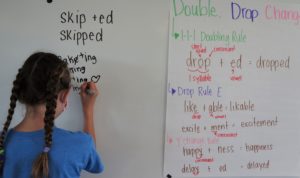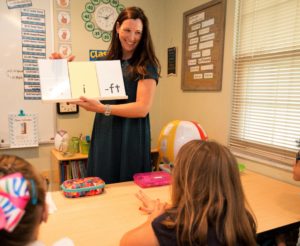Over the years, they may have had the nicest teachers or been able to “pass” their classes, yet they never fully develop into good readers. They are reliant on context clues, guessing, and compensating. These students are bright and talented in other ways and are vastly aware of their reading struggles.
Scientists know how children learn to decode, yet many teachers are not taught the structure of language. Often, schools converge a large group of teachers who use a vast array of reading curricula, teaching methods, and resources.
Although we may not be able to identify the specific reasons why students lack the skills to read, we know that what they have had in the past has not been effective. To ensure highly effective intervention across the grades at Pinnacle Academy, we determined that unified training in one methodology would best support structured literacy in our classrooms.
Orton-Gillingham pioneered the multi-sensory approach to teaching reading and was a complement to our brain-based learning approach. For our school, professional development with IMSE made good sense. The training and available resources are developed by teachers and include a thoughtful selection of materials.
As teachers join our faculty, they complete IMSE’s Comprehensive professional training, where they develop a deep understanding of language systems and exposure to an extensive research-base regarding how children learn to read. This 30-hour training provides our teachers with practical application strategies, scope and sequence, interconnected assessment data, the ability to collaborate with their peers, and resources that minimize reading difficulties and maximize success. Whether a teacher is new to the field or seasoned by 30 years, our faculty return from training energized and equipped to identify and meet their students’ needs.
In reviewing student data, we are keenly aware of their deficiencies which identify a weakness in word recognition/decoding and/or language comprehension. Gough and Tunmer’s Simple View of Reading emphasizes the effect that these weaknesses have on reading comprehension. Our faculty’s deep understanding of this formula drives both assessment and instruction across the campus. Our goal is to provide students with the tools to become expert decoders to tackle content knowledge in all domains and across the grade levels.
Across the primary and elementary classes, our days are filled with engaging lessons that deliver a combination of direct, explicit instruction that is continually monitored and scaffolded. Teachers develop their schedules to support specific blocks that are devoted to targeting skill acquisition and application while incorporating learning standards across subjects. Here is what OG instruction looks like throughout the week in grades K-6:
Multi-Sensory Structured Reading (M.S.S.R)
This 45-60 minute block is offered daily and follows IMSE’s recommended instruction schedule.
Monday
The Three-Part Drill integrates multiple sensory pathways and promotes letter-sound proficiency. Phoneme awareness is combined with grapheme knowledge to solidify the student’s understanding of the alphabetic code. This drill stimulates the review and repetition cycle that leads to rapid recognition.
Introduction of the New Concept is unveiled and students are excited to learn a new phoneme, spelling rule, pattern, or strategy. The Multisensory Experience connects the concept with an object, spelling application, literature, and brainstorming its use in words.
Practice Dictation provides repeated opportunities for the student to apply the new concept to spelling practice. This component is essential to ensure that the teacher supports the student in errorless learning and that students are dissecting words. This is a no guessing zone! Following the spelling application, students edit their work using the CUPS strategy, teachers weave in questions to promote direct mapping, and words and sentences are re-read to promote fluency.
Tuesday
On Tuesday, students will Review Red Words by arm tapping each word and playing extension activities to promote motor memory. Red Word ZAP and Tic Tac Toe are two of our favorites! New words are introduced in Red Word Instruction. Students at every grade are engaged in discussions to identify irregular letter-sound connections, follow the steps of learning new words, and add them to their Red Word folders for review. Extension Activities will focus on the new concept that was taught in Monday’s lesson. This may include multiple spellings practice, the use of decodable readers, concept-driven nonsense word decoding and encoding practice, and fluency drills with rapid word charts.
Wednesday
 A Three-Part Drill begins the lesson and integrates the new concept. Once students learn open and closed syllables, they are taught the syllable patterns and types in sequential order. Decoding Practice is conducted weekly to support the student’s use of strategies in syllabication. This is a classroom favorite, as students gain confidence in their ability to activate their linguistic vocabulary knowledge which builds the foundation for orthographic mapping.
A Three-Part Drill begins the lesson and integrates the new concept. Once students learn open and closed syllables, they are taught the syllable patterns and types in sequential order. Decoding Practice is conducted weekly to support the student’s use of strategies in syllabication. This is a classroom favorite, as students gain confidence in their ability to activate their linguistic vocabulary knowledge which builds the foundation for orthographic mapping.
The evidence of learning is clear when students are engaging in decoding conversations that include words like consonant, vowel, Magic -e, syllable, blend, digraph, and schwa. More opportunities for Practice Dictation are necessary for students to gain mastery of this week’s concept. This allows for teachers to assess the need for additional support. Extension Activities will target Red Word spelling practice. Decodable Readers are used to practice the new concept in print.
Thursday
Students take a Practice Test that includes both real and nonsense words with the new concept, review concepts, and Red Words. The practice test is administered without prompts, cues, or teacher support and offers the teacher time to provide direct intervention to students who performed below 80%. Word Study and fluency activities will be completed by students who performed well on the test. Decodable Readers are used to continue to build automaticity with the new concept.
Friday
Students take a Weekly Test with a different set of words (same target concepts). The teacher engages the students in Word Study activities, decodable readers, and quick drills to build automaticity.
Daily Activities
Brain Breaks (5-15 minutes)
Brain breaks provide an excellent opportunity to incorporate movement, drills, or game formats for word study activities. However, the primary focus of the brain break is to absorb students in activities to promote phonological awareness. In grades K-3, students are administered the PAST and skills that have not been mastered become the focus of fun, engaging activities. Students may advance through leveled one-minute activities (Equipped for Reading Success, Kilpatrick) and morphological awareness activities.
Language Arts (45-60 minutes)
The language arts block offers three learning stations (direct-teacher instruction, independent practice, small group). Students are grouped to allow for differentiation of instruction. Teachers target the language arts standards, providing remediation and accelerated pacing or content to suit the student’s needs. This daily, direct instruction allows for formative and summative assessment to drive instruction. Teachers select the curriculum and resources to instruct and accommodate student learning. The oral reading fluency (ORF) “cold read” is conducted on Monday and the “hot read” on Friday.
Writer’s Workshop (30 minutes)
This block integrates executive function skills to teach students to develop text composition. Sentences, paragraphs, and essays are created in a systematic, sequential writing process that scaffolds to align with grade-level standards. Students are taught to self-edit for grammatical understanding, discourse comprehension, and content. The finished product will complement the grading rubric.
Read Aloud (30 minutes)
Where students struggle with decoding, they may possess average to above-average oral language comprehension skills. Our students do not have a history of independent reading experiences and these missed opportunities to read can impede their growth of vocabulary and background knowledge. A dedicated block of time allows for the student to gain exposure to text at or above their grade level. Teachers select a book to read aloud that will provide for rich vocabulary exposure, activated metacognition, inferencing, and text connections. Reciprocal Teaching (Oczkus) and Visualizing & Verbalizing (LindaMood Bell) strategies are woven in to ensure that students have a meaningful interaction with language. In addition, our students develop positive experiences to ignite a love for reading.
Take-Home
Some students receive additional tutoring and others are assigned an application binder to continue to apply skills as an extension of school time. The binder is divided with tabs and includes a rapid word chart for Red Words and for green words, oral reading fluency drills, nonsense word reading, and decodable text.
School Essentials
At Pinnacle Academy, structured literacy is understood and ubiquitous. Comparison data (collected quarterly) indicates remarkable gains in strategy usage, linguistic vocabulary, and skill acquisition for students of all ages. Essentially, the students who previously lacked the basic skills to read are now thinking about reading and able to explain the how and why of the letter-sound system. The delivery of powerful research-based intervention would not be possible without highly effective training, ongoing support, and passionate educators. As Dr. Louisa Moats states, “Teaching reading is rocket science.” Teachers need to be equipped with the expert-level knowledge of language that is necessary to teach reading. Through IMSE, our teachers have access to continued education, professional development/certification, and an endless collection of materials and resources to support and inspire instruction.
About The Author
 Dr. Kirstina Ordetx is a Level 4 Master Instructor with The Institute for Multi-Sensory Education (IMSE). She holds a doctorate in Counseling Psychology with a concentration in pediatric neurology. Dr. Ordetx is an educational specialist with over 25 years of clinical experience, research, and consultation. She is a certified Structured Literacy Dyslexia Interventionist through the Center for Effective Reading Instruction, a Certified Nutrition and Wellness Consultant, Executive Functions Coach, and a registered Licensed Mental Health Intern. Dr. Ordetx has published two books that compile her research and practice in Theory of Mind. She has served on accreditation committees for the Florida Council of Independent Schools, is a university adjunct professor in developmental and child psychology, and presents at various national and international conferences. Dr. Ordetx is head of school for a private academy in Lakewood Ranch, Florida specializing in the multi-sensory education of students who have language and learning-based differences. She is the Executive Director of the Pinnacle Pediatric Therapy Group, a multi-disciplinary, pediatric therapy clinic.
Dr. Kirstina Ordetx is a Level 4 Master Instructor with The Institute for Multi-Sensory Education (IMSE). She holds a doctorate in Counseling Psychology with a concentration in pediatric neurology. Dr. Ordetx is an educational specialist with over 25 years of clinical experience, research, and consultation. She is a certified Structured Literacy Dyslexia Interventionist through the Center for Effective Reading Instruction, a Certified Nutrition and Wellness Consultant, Executive Functions Coach, and a registered Licensed Mental Health Intern. Dr. Ordetx has published two books that compile her research and practice in Theory of Mind. She has served on accreditation committees for the Florida Council of Independent Schools, is a university adjunct professor in developmental and child psychology, and presents at various national and international conferences. Dr. Ordetx is head of school for a private academy in Lakewood Ranch, Florida specializing in the multi-sensory education of students who have language and learning-based differences. She is the Executive Director of the Pinnacle Pediatric Therapy Group, a multi-disciplinary, pediatric therapy clinic.
Sign up for our LIVE virtual Orton-Gillingham training! We are now offering half-day, evening, and weekend options to best fit your schedule.
The IMSE approach allows teachers to incorporate the five components essential to an effective reading program into their daily lessons: phonemic awareness, phonics, vocabulary, fluency, and comprehension.
The approach is based on the Orton-Gillingham methodology and focuses on explicit, direct instruction that is sequential, structured, and multi-sensory.
It is IMSE’s mission that all children must have the ability to read to fully realize their potential. We are committed to providing teachers with the knowledge and tools to prepare future minds.
Please connect with us on Facebook, Twitter, and Pinterest to get tips and tricks from your peers and us. Read the IMSE Journal to hear success stories from other schools and districts, and be sure to read the OG Weekly email series for refreshers and tips.


